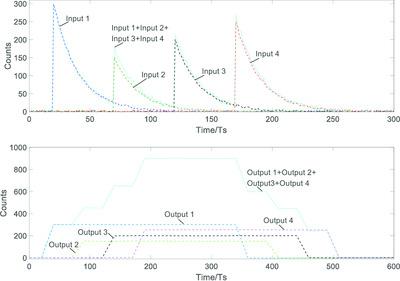当前位置:
X-MOL 学术
›
J. Synchrotron Radiat.
›
论文详情
Our official English website, www.x-mol.net, welcomes your feedback! (Note: you will need to create a separate account there.)
Estimation of trapezoidal‐shaped overlapping nuclear pulse parameters based on a deep learning CNN‐LSTM model
Journal of Synchrotron Radiation ( IF 2.5 ) Pub Date : 2021-04-19 , DOI: 10.1107/s1600577521003441 Xing-Ke Ma , Hong-Quan Huang , Xiao Ji , He-Ye Dai , Jun-Hong Wu , Jing Zhao , Fei Yang , Lin Tang , Kai-Ming Jiang , Wei-Cheng Ding , Wei Zhou
Journal of Synchrotron Radiation ( IF 2.5 ) Pub Date : 2021-04-19 , DOI: 10.1107/s1600577521003441 Xing-Ke Ma , Hong-Quan Huang , Xiao Ji , He-Ye Dai , Jun-Hong Wu , Jing Zhao , Fei Yang , Lin Tang , Kai-Ming Jiang , Wei-Cheng Ding , Wei Zhou

|
The Long Short‐Term Memory neural network (LSTM) has excellent learning ability for the time series of the nuclear pulse signal. It can accurately estimate the parameters (such as amplitude, time constant, etc.) of the digitally shaped nuclear pulse signal (especially the overlapping pulse signal). However, due to the large number of pulse sequences, the direct use of these sequences as samples to train the LSTM increases the complexity of the network, resulting in a lower training efficiency of the model. The convolution neural network (CNN) can effectively extract the sequence samples by using its unique convolution kernel structure, thus greatly reducing the number of sequence samples. Therefore, the CNN‐LSTM deep neural network is used to estimate the parameters of overlapping pulse signals after digital trapezoidal shaping of exponential signals. Firstly, the estimation of the trapezoidal overlapping nuclear pulse is considered to be obtained after the superposition of multiple exponential nuclear pulses followed by trapezoidal shaping. Then, a data set containing multiple samples is set up; each sample is composed of the sequence of sampling values of the trapezoidal overlapping nuclear pulse and the set of shaping parameters of the exponential pulse before digital shaping. Secondly, the CNN is used to extract the abstract features of the training set in these samples, and then these abstract features are applied to the training of the LSTM model. In the training process, the pulse parameter set estimated by the present neural network is calculated by forward propagation. Thirdly, the loss function is used to calculate the loss value between the estimated pulse parameter set and the actual pulse parameter set. Finally, a gradient‐based optimization algorithm is applied to update the weight by getting back the loss value together with the gradient of the loss function to the network, so as to realize the purpose of training the network. After model training was completed, the sampled values of the trapezoidal overlapping nuclear pulse were used as input to the CNN‐LSTM model to obtain the required parameter set from the output of the CNN‐LSTM model. The experimental results show that this method can effectively overcome the shortcomings of local convergence of traditional methods and greatly save the time of model training. At the same time, it can accurately estimate multiple trapezoidal overlapping pulses due to the wide width of the flat top, thus realizing the optimal estimation of nuclear pulse parameters in a global sense, which is a good pulse parameter estimation method.
中文翻译:

基于深度学习CNN-LSTM模型的梯形重叠核脉冲参数估计
长短期记忆神经网络(LSTM)对于核脉冲信号的时间序列具有出色的学习能力。它可以准确估计参数(例如幅度,时间常数等))的数字形状的核脉冲信号(特别是重叠的脉冲信号)。然而,由于大量的脉冲序列,将这些序列直接用作样本来训练LSTM会增加网络的复杂性,从而导致模型的训练效率降低。卷积神经网络(CNN)可以利用其独特的卷积核结构有效地提取序列样本,从而大大减少了序列样本的数量。因此,在对指数信号进行数字梯形整形后,使用CNN‐LSTM深层神经网络来估计重叠脉冲信号的参数。首先,梯形重叠核脉冲的估计被认为是在多个指数核脉冲叠加之后进行梯形整形之后获得的。然后,建立包含多个样本的数据集;每个样本由梯形重叠核脉冲的采样值序列和数字整形之前的指数脉冲的整形参数集组成。其次,使用CNN提取这些样本中训练集的抽象特征,然后将这些抽象特征应用于LSTM模型的训练。在训练过程中,通过前向传播来计算由当前神经网络估计的脉冲参数集。第三,损失函数用于计算估计的脉冲参数集和实际的脉冲参数集之间的损失值。最后,应用基于梯度的优化算法通过将损失值与损失函数的梯度一起返回网络来更新权重,从而达到训练网络的目的。模型训练完成后,梯形重叠核脉冲的采样值用作CNN-LSTM模型的输入,以从CNN-LSTM模型的输出中获得所需的参数集。实验结果表明,该方法可以有效克服传统方法局部收敛的缺点,大大节省了模型训练的时间。同时,由于平顶较宽,可以准确估计多个梯形重叠脉冲,从而在全局意义上实现了对核脉冲参数的最优估计,是一种很好的脉冲参数估计方法。梯形重叠核脉冲的采样值用作CNN-LSTM模型的输入,以从CNN-LSTM模型的输出中获得所需的参数集。实验结果表明,该方法可以有效克服传统方法局部收敛的缺点,大大节省了模型训练的时间。同时,由于平顶较宽,可以准确估计多个梯形重叠脉冲,从而在全局意义上实现了对核脉冲参数的最优估计,是一种很好的脉冲参数估计方法。梯形重叠核脉冲的采样值用作CNN-LSTM模型的输入,以从CNN-LSTM模型的输出中获得所需的参数集。实验结果表明,该方法可以有效克服传统方法局部收敛的缺点,大大节省了模型训练的时间。同时,由于平顶较宽,可以准确估计多个梯形重叠脉冲,从而在全局意义上实现了对核脉冲参数的最优估计,是一种很好的脉冲参数估计方法。实验结果表明,该方法可以有效克服传统方法局部收敛的缺点,大大节省了模型训练的时间。同时,由于平顶较宽,可以准确估计多个梯形重叠脉冲,从而在全局意义上实现了对核脉冲参数的最优估计,是一种很好的脉冲参数估计方法。实验结果表明,该方法可以有效克服传统方法局部收敛的缺点,大大节省了模型训练的时间。同时,由于平顶较宽,可以准确估计多个梯形重叠脉冲,从而在全局意义上实现了对核脉冲参数的最优估计,是一种很好的脉冲参数估计方法。
更新日期:2021-05-06
中文翻译:

基于深度学习CNN-LSTM模型的梯形重叠核脉冲参数估计
长短期记忆神经网络(LSTM)对于核脉冲信号的时间序列具有出色的学习能力。它可以准确估计参数(例如幅度,时间常数等))的数字形状的核脉冲信号(特别是重叠的脉冲信号)。然而,由于大量的脉冲序列,将这些序列直接用作样本来训练LSTM会增加网络的复杂性,从而导致模型的训练效率降低。卷积神经网络(CNN)可以利用其独特的卷积核结构有效地提取序列样本,从而大大减少了序列样本的数量。因此,在对指数信号进行数字梯形整形后,使用CNN‐LSTM深层神经网络来估计重叠脉冲信号的参数。首先,梯形重叠核脉冲的估计被认为是在多个指数核脉冲叠加之后进行梯形整形之后获得的。然后,建立包含多个样本的数据集;每个样本由梯形重叠核脉冲的采样值序列和数字整形之前的指数脉冲的整形参数集组成。其次,使用CNN提取这些样本中训练集的抽象特征,然后将这些抽象特征应用于LSTM模型的训练。在训练过程中,通过前向传播来计算由当前神经网络估计的脉冲参数集。第三,损失函数用于计算估计的脉冲参数集和实际的脉冲参数集之间的损失值。最后,应用基于梯度的优化算法通过将损失值与损失函数的梯度一起返回网络来更新权重,从而达到训练网络的目的。模型训练完成后,梯形重叠核脉冲的采样值用作CNN-LSTM模型的输入,以从CNN-LSTM模型的输出中获得所需的参数集。实验结果表明,该方法可以有效克服传统方法局部收敛的缺点,大大节省了模型训练的时间。同时,由于平顶较宽,可以准确估计多个梯形重叠脉冲,从而在全局意义上实现了对核脉冲参数的最优估计,是一种很好的脉冲参数估计方法。梯形重叠核脉冲的采样值用作CNN-LSTM模型的输入,以从CNN-LSTM模型的输出中获得所需的参数集。实验结果表明,该方法可以有效克服传统方法局部收敛的缺点,大大节省了模型训练的时间。同时,由于平顶较宽,可以准确估计多个梯形重叠脉冲,从而在全局意义上实现了对核脉冲参数的最优估计,是一种很好的脉冲参数估计方法。梯形重叠核脉冲的采样值用作CNN-LSTM模型的输入,以从CNN-LSTM模型的输出中获得所需的参数集。实验结果表明,该方法可以有效克服传统方法局部收敛的缺点,大大节省了模型训练的时间。同时,由于平顶较宽,可以准确估计多个梯形重叠脉冲,从而在全局意义上实现了对核脉冲参数的最优估计,是一种很好的脉冲参数估计方法。实验结果表明,该方法可以有效克服传统方法局部收敛的缺点,大大节省了模型训练的时间。同时,由于平顶较宽,可以准确估计多个梯形重叠脉冲,从而在全局意义上实现了对核脉冲参数的最优估计,是一种很好的脉冲参数估计方法。实验结果表明,该方法可以有效克服传统方法局部收敛的缺点,大大节省了模型训练的时间。同时,由于平顶较宽,可以准确估计多个梯形重叠脉冲,从而在全局意义上实现了对核脉冲参数的最优估计,是一种很好的脉冲参数估计方法。



























 京公网安备 11010802027423号
京公网安备 11010802027423号